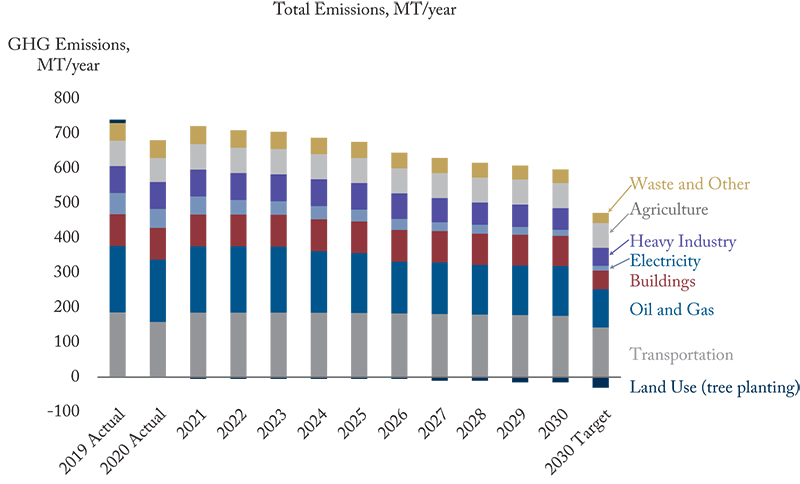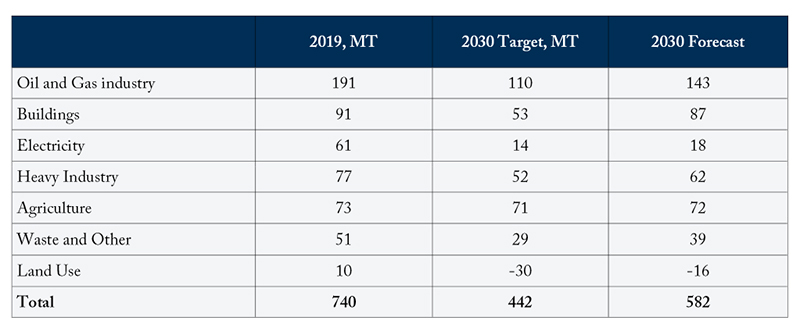The federal government’s ambitious Emissions Reduction Plan (ERP) sets out targets for seven economic sectors as it aims to cut 2030 emissions by 42 percent from 2019 levels. But the ERP is merely a plan to have a plan. It contains no specific steps to meet its targets, or any mechanism for measuring the progress towards such targets on a year-by-year basis. This special series of Intelligence Memos introduces seven forecast models tailored to each sector that provide a realistic assessment of what’s needed to meet Ottawa’s goals, and each sector’s key variables to emission reductions. This Memo concludes the series (see previous entries of the largest emitting sectors of transportation, oil and gas, buildings, and other sectors). The charts and spreadsheets underlying this work can be found here.
To: The Hon. Steven Guilbeault, Minister of Environment and Climate Change
From: Brian Livingston
Date: January 25, 2023
Re: Missing the Emission Reduction Mark: Let Us Count the Ways
Last March, Ottawa announced its target for greenhouse gas (GHG) emissions in 2030. It wants them down 40 percent by 2030, from 740 million tonnes (MT) of CO2-equivalent in 2019 to 442 MT.
Setting targets is a lot easier than hitting them. Ottawa’s Emissions Reduction Plan is long on policies and programs but short on what needs to actually happen.
My own analysis, available on the C.D. Howe Institute website, suggests the 2030 reduction will be, at best, only 158 MT – only a little over halfway to Ottawa’s target. (Carbon dioxide is a relatively heavy gas, and a metric tonne of pure carbon dioxide – think 400 bricks – would fill a 27-foot cube.)
I built my emission forecast on fact-based, bottom-up calculations.
On transportation, for example, Ottawa plans a 23 percent reduction from 186 MT to 143 MT. It assumes that 1.1 million cars and light trucks – 60 percent of the 1.8-million sold in 2030 – will be electric. Last year’s EV sales were about 80,000. That means electric vehicle sales need to increase by 14 times, with an implied annual growth rate of about 40 percent.
Ottawa also assumes 2030 sales of 100,000 heavy freight trucks will be 40-percent electric. Currently, there are virtually none on the road.
Nowhere does Ottawa say where these electric vehicles will come from. It appears to assume that cash incentives, financial assistance to vehicle manufacturers and mandating the sale of electric vehicles while banning the sale of internal-combustion engine vehicles will somehow achieve these targets. Meanwhile, there is growing doubt that auto industry can comply with EV mandates.
I examined, company-by-company, the capacity and intention to assemble and sell electric vehicles. That produces a vehicle-sale forecast in 2030 of only 310,000 EVs (about 95,000 from Tesla, 150,000 from GM, Ford and Stellantis and 65,000 from more than 10 other companies.) Assuming Canada gets its historical 2-percent share of global vehicle sales, the figure for Tesla sales in Canada is 2 percent of the assumed global Tesla 2030 sales of five million EVs.
Overall, lower EV sales cause a slower turnover of existing vehicles, resulting in just 2.2 million EVs in a 24-million vehicle fleet. Meanwhile, the federal government is projecting 1.1 million in annual EV sales by 2030.
The freight truck result is similar, with EV sales hitting only 22 percent of 2030 sales, accounting for only 10 percent of the fleet. Bottom line? Fewer EVs result in 33 MT more transportation emissions than Ottawa’s 143 MT target.
Buildings present a similar problem. Ottawa is pinning its hopes on the installation of about 600,000 heat pumps per year between now and 2030 in residential, commercial and industrial buildings. Its $5,000 grant to homeowners to retrofit their current house with a heat pump is the carrot, along with investment tax credits to encourage heat pumps for commercial and industrial buildings.
However, there is no explanation or strategy addressing the actual task of heat pump installation.
Canada has only put about 20,000 into service every year between 2000 and 2016.
The federal projection of 600,000 per year borders on fantasy. Instead, my model assumes growth at a more modest 25 percent, which produces annual heat pump installations of 230,000 by 2030. Building emissions then hit 86 MT, much higher than Ottawa’s 53MT target.
Using a similar “specific facts” approach for the other six sectors – oil and gas, heavy industry, electricity, waste, agriculture and land use – I get 2030 emissions of 319 MT emissions, much higher than the 246-MT official target.
Adding all these numbers together gives a forecast reduction of only 158 MT, some 47 percent short of Ottawa’s target of 298 MT. For just an eight-year forecast, that’s not very good, not even for government work.
Brian Livingston is an executive fellow at the School of Public Policy at the University of Calgary.
To send a comment or leave feedback, email us at blog@cdhowe.org.
The views expressed here are those of the author. The C.D. Howe Institute does not take corporate positions on policy matters.
A version of the Memo first appeared in the Financial Post.







